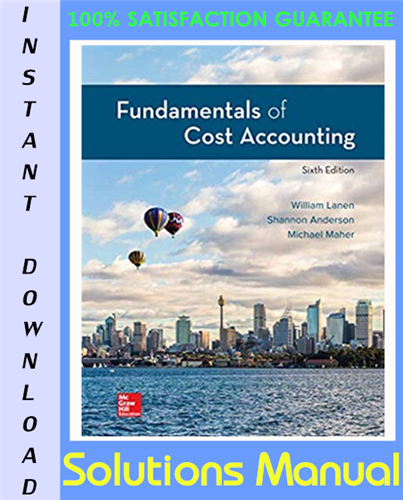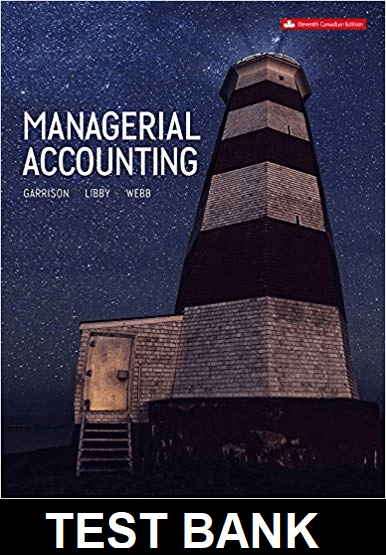Solution Manual for Fundamentals of Cost Accounting 6th Edition by Lanen
Solution Manual for Fundamentals of Cost Accounting 6th Edition by Lanen
Fundamentals of Cost Accounting 6th Edition by Lanen – Solution Manual
Fundamentals of Cost Accounting 6th Edition
Fundamentals of Cost Accounting
Chapter 1
Cost Accounting: Information for DecisionMaking
Learning Objectives
- Describe the way managers use accounting information to create value in organizations.
- Distinguish between the uses and users of cost accounting and financial accounting information.
- Explain how cost accounting information is used for decision making and performance evaluation in organizations.
- Identify current trends in cost accounting.
- Understand ethical issues faced by accountants and ways to deal with ethical problems that you face in your career.
Chapter Overview
- VALUE CREATION IN ORGANIZATIONS
- Why Start with Value Creation?
- Value Chain
- Supply Chain and Distribution Chain
- Using Cost Information to Increase Value
- Accounting and the Value Chain
- ACCOUNTING SYSTEMS
- Financial Accounting
- Cost Accounting
- Cost Accounting, GAAP, and IFRS
- Customers of Cost Accounting
III. OUR FRAMEWORK FOR ASSESSING COST ACCOUNTING SYSTEMS
- The Manager’s Job Is to Make Decisions
- Decision Making Requires Information
- Finding and Eliminating Activities That Don’t Add Value
- Identifying Strategic Opportunities Using Cost Analysis
- Owners Use Cost Information to Evaluate Managers
- COST DATA FOR MANAGERIAL DECISIONS
- Costs for Decision Making
- Costs for Control and Evaluation
- Budgeting
- Different Data for Different Decisions
- TRENDS IN COST ACCOUNTINGthroughout the value chain
- Cost Accounting in Research and Development (R&D)
- Cost Accounting in Design
- Cost Accounting in Purchasing
- Cost Accounting in Production
- Cost Accounting in Marketing
- Cost Accounting in Distribution
- Cost Accounting in Customer Service
- Enterprise Resource Planning
- Creating Value in the Organization
- KEY FINANCIAL PLAYERS IN THE ORGANIZATION
Chapter Overview, continued
VII. CHOICES: ETHICAL ISSUES FOR ACCOUNTANTS
- What Makes Ethics So Important?
- Ethics
- The Sarbanes-Oxley Act of 2002 and Ethics
VIII. COST ACCOUNTING AND OTHER BUSINESS DISCIPLINES
- APPENDIX: INSTITUTE OF MANAGEMENT ACCOUNTANTS CODE OF ETHICS
- Statements of Ethical Professional Practice
- Principles
- Standards
- Resolving Ethical Issues
Chapter Outline
LO 1-1 Describe the way managers use accounting information to create value in organizations.
VALUE CREATION IN ORGANIZATIONS
- Why Start with Value Creation?
- Goal of cost accounting is to assist manages in achieving the maximum value for their organizations.
- Value Chain
- The value chain is the set of activities that transforms raw resources into the goods and services end users purchase and consume.
- It includes the treatment or disposal of any waste generated by the end users.
- Value-added activities are those that customers perceive as adding utility to the goods or services they purchase.
- Exhibit 1.1 identifies the individual components of the value chain and providesexamples of the activities in each component, along with some of the costs associatedwith these activities.Although the list of value chain components suggests a sequential process, many of the components overlap.
- Research and development (R&D): The creation and development of ideas related to new products, services, or processes.
- Design: The detailed development and engineering of products, services, or processes.
- Purchasing: The acquisition of goods and services needed to produce a good or service.
- Production: The collection and assembly of resources to produce a product or deliver a service.
- Marketing and Sales: The process of informing potential customers about the attributes of products or services that leads to their sale.
- Distribution: The process for delivering products or services to customers.
- Customer service: The support activities provided to customers for a product or service.
- Before product ideas are formulated,no value exists. Once an idea is established, however, value is created.
- Whenresearch and development of the product begins, value increases.
- As the productreaches the design phase, value continues to increase.
- Each component adds value tothe product or service.
- Administrative functions, such as human resource management and accounting, are not included as part of the value chain; they are included instead in every business function of the value chain.
- Supply Chain and Distribution Chain
- The supply chainincludes the set of firms and individualsthat sells goods and servicesto the firm. (See Business Application box “Choosing Where to Produce in the Supply Chain.”)
- The distribution chainincludes the set of firms and individualsthat buys and distributesgoods and services fromthe firm.
- These suppliers and customers are on the firm’s boundaries. Thus, the supply chain and distribution chain are the parts of the value chain outside the firm.
- Using Cost Information to Increase Value
- The measurement and reporting of costs is avaluable activity.
- Cost information that is received too late to help managersmakedecisionswould not add value.
- Accounting and the Value Chain
- Cost accounting focuses on how the individual stages contribute to the value and how to work with other managers to improve performance.












